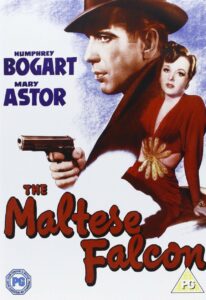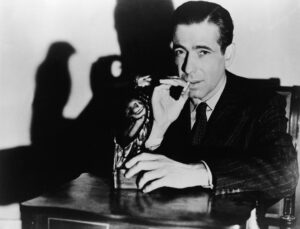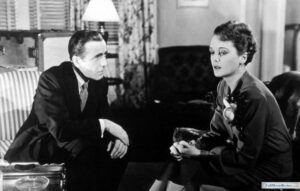“The Maltese Falcon” – Loneliness in the Big City [Analysis]

Title: “The Maltese Falcon”
Release Date: 1941
Director: John Huston
Cast: Humphrey Bogart, Mary Astor, Gladys George, Peter Lorre, Barton MacLane, Lee Patrick, Ward Bond, Sydney Greenstreet
John Huston, realizing “The Maltese Falcon” based on Hammet’s famous novel, launched a trend of cinema noir, different from the classic crime film. For the intrigue here unfolds in the heart of the urban jungle, where a lonely man is on his own and can trust no one.
Humphrey Bogart as Sam Spade
“The Maltese Falcon” is a story about a private detective who, due to the intrigue of a beautiful, dangerous woman, must fight for survival. The film is set in the 1930s in San Francisco. Here in the office of Sam Spade (played by Humphrey Bogart) appears a mysterious lady, a certain Brigid O’Shaughnessy (Mary Astor), who offers a commission to find her allegedly abducted younger sister. When Sam’s partner, Detective Miles Archer (Jerome Cowan) goes to the address to track the suspected kidnapper, he is shot dead. It soon turns out that the story with the missing sister was concocted by Brigit, who is hiding a valuable statuette of a falcon lost in the 16th century and on the run from a menacing shaykh. Eventually, thanks to the intrigue of a beautiful woman, Spade finds himself simultaneously targeted by the police and the Mafia.
Humphrey Bogart created a great performance in the movie “The Maltese Falcon”, which has become one of his iconic roles. He managed to portray a morally ambiguous character – for Sam is a lover of his accomplice’s wife, which is a serious stain on his honor. On the other hand, the protagonist is guided by a certain code of principles, according to which he is obliged to solve the mystery of his partner’s death at all costs. This requires the man to reject lucrative financial offers from Kasper Gutman and Joel Kairo (played by Peter Lorre), who offer him to participate in a business deal with the legendary falcon.

Ultimately, the object of desire of the dangerous socialite turns out to be a forgery. What’s more, the woman with whom Spade strikes up an affair is unmasked as a ruthless killer, and the detective, despite his affection for Miss O’Shaughnessy, decides to turn her in.
“The Maltese Falcon” – Huston the creator of film noir
“The Maltese Falcon” is first and foremost a flagship example of cinema noir. The film’s plot is set in an urban maze from which there is no escape. Most of the scenes take place in interiors lit by artificial light, which emphasizes the entrapment of the characters in a web of intrigue, but also in the space of their own desires and fears. Darkness, rain and the light of street lamps create the characteristic mysterious atmosphere of the film. The atmosphere of John Huston’s picture is situated on the border between java and dream. It is also lined with paranoid anxiety. Nothing in this world is obvious, and the police, who are supposed to be a beacon of safety, seem as suspicious as a shaykh of falcon-hunting villains.
Huston’s work also could not miss the figure of the femme fatale – a beautiful and dangerous woman who leads to the doom of all the men fascinated by her. Seemingly delicate and distinguished lady in reality is a ruthless assassin who does not hesitate to remove anyone who stands in her way to wealth. At the same time, Miss O’Shaughnessy’s charm is compelling, and it’s hard not to succumb to it also for the prudent and cynical detective. And so it is that Brigit puts Spade in a difficult situation – he will either hand over to the police the woman he has feelings for, or risk death at her hands.

The movie “The Maltese Falcon” – the false face of the golden calf
The leitmotiv of “The Maltese Falcon” is greed. Lust for possession drives the motivation of the characters’ behavior and at the same time destroys all their personal relationships. No one can trust anyone here, best exemplified by the attitude of Kasper Gutman. The stocky gentleman, in the name of acquiring the statue, does not hesitate to sacrifice his bodyguard, whom he treats like a son. In doing so, he utters the telling words: “I couldn’t be fonder of you if you were my own son. But, well, if you lose a son, its possible to get another. There’s only one Maltese Falcon.”
Made of precious metals, the statuette grows in Huston’s movie to become a key symbol of mammon. It brings to mind the biblical figure of the golden calf, which was worshipped by the blinded Israelites. In turn, the illusory nature of its divinity is exposed in a significant scene, when it turns out that the falcon is a forgery. Several people thus lose their lives in the name of a false god.
“The Maltese Falcon” also shows the personal isolation of the characters. In the jungle of the big city, where everyone is just trying to get as much as possible for themselves, a person is on his own, and any intimate contact is fraught with danger.
